Ashish Kundu
CISCO Research, USA
SOFT: Selective Data Obfuscation for Protecting LLM Fine-tuning against Membership Inference Attacks
Jun 12, 2025Abstract:Large language models (LLMs) have achieved remarkable success and are widely adopted for diverse applications. However, fine-tuning these models often involves private or sensitive information, raising critical privacy concerns. In this work, we conduct the first comprehensive study evaluating the vulnerability of fine-tuned LLMs to membership inference attacks (MIAs). Our empirical analysis demonstrates that MIAs exploit the loss reduction during fine-tuning, making them highly effective in revealing membership information. These findings motivate the development of our defense. We propose SOFT (\textbf{S}elective data \textbf{O}bfuscation in LLM \textbf{F}ine-\textbf{T}uning), a novel defense technique that mitigates privacy leakage by leveraging influential data selection with an adjustable parameter to balance utility preservation and privacy protection. Our extensive experiments span six diverse domains and multiple LLM architectures and scales. Results show that SOFT effectively reduces privacy risks while maintaining competitive model performance, offering a practical and scalable solution to safeguard sensitive information in fine-tuned LLMs.
Apollo: A Posteriori Label-Only Membership Inference Attack Towards Machine Unlearning
Jun 11, 2025Abstract:Machine Unlearning (MU) aims to update Machine Learning (ML) models following requests to remove training samples and their influences on a trained model efficiently without retraining the original ML model from scratch. While MU itself has been employed to provide privacy protection and regulatory compliance, it can also increase the attack surface of the model. Existing privacy inference attacks towards MU that aim to infer properties of the unlearned set rely on the weaker threat model that assumes the attacker has access to both the unlearned model and the original model, limiting their feasibility toward real-life scenarios. We propose a novel privacy attack, A Posteriori Label-Only Membership Inference Attack towards MU, Apollo, that infers whether a data sample has been unlearned, following a strict threat model where an adversary has access to the label-output of the unlearned model only. We demonstrate that our proposed attack, while requiring less access to the target model compared to previous attacks, can achieve relatively high precision on the membership status of the unlearned samples.
How Good LLM-Generated Password Policies Are?
Jun 10, 2025Abstract:Generative AI technologies, particularly Large Language Models (LLMs), are rapidly being adopted across industry, academia, and government sectors, owing to their remarkable capabilities in natural language processing. However, despite their strengths, the inconsistency and unpredictability of LLM outputs present substantial challenges, especially in security-critical domains such as access control. One critical issue that emerges prominently is the consistency of LLM-generated responses, which is paramount for ensuring secure and reliable operations. In this paper, we study the application of LLMs within the context of Cybersecurity Access Control Systems. Specifically, we investigate the consistency and accuracy of LLM-generated password policies, translating natural language prompts into executable pwquality.conf configuration files. Our experimental methodology adopts two distinct approaches: firstly, we utilize pre-trained LLMs to generate configuration files purely from natural language prompts without additional guidance. Secondly, we provide these models with official pwquality.conf documentation to serve as an informative baseline. We systematically assess the soundness, accuracy, and consistency of these AI-generated configurations. Our findings underscore significant challenges in the current generation of LLMs and contribute valuable insights into refining the deployment of LLMs in Access Control Systems.
An Outlook on the Opportunities and Challenges of Multi-Agent AI Systems
May 23, 2025Abstract:Multi-agent AI systems (MAS) offer a promising framework for distributed intelligence, enabling collaborative reasoning, planning, and decision-making across autonomous agents. This paper provides a systematic outlook on the current opportunities and challenges of MAS, drawing insights from recent advances in large language models (LLMs), federated optimization, and human-AI interaction. We formalize key concepts including agent topology, coordination protocols, and shared objectives, and identify major risks such as dependency, misalignment, and vulnerabilities arising from training data overlap. Through a biologically inspired simulation and comprehensive theoretical framing, we highlight critical pathways for developing robust, scalable, and secure MAS in real-world settings.
Malware Detection at the Edge with Lightweight LLMs: A Performance Evaluation
Mar 06, 2025Abstract:The rapid evolution of malware attacks calls for the development of innovative detection methods, especially in resource-constrained edge computing. Traditional detection techniques struggle to keep up with modern malware's sophistication and adaptability, prompting a shift towards advanced methodologies like those leveraging Large Language Models (LLMs) for enhanced malware detection. However, deploying LLMs for malware detection directly at edge devices raises several challenges, including ensuring accuracy in constrained environments and addressing edge devices' energy and computational limits. To tackle these challenges, this paper proposes an architecture leveraging lightweight LLMs' strengths while addressing limitations like reduced accuracy and insufficient computational power. To evaluate the effectiveness of the proposed lightweight LLM-based approach for edge computing, we perform an extensive experimental evaluation using several state-of-the-art lightweight LLMs. We test them with several publicly available datasets specifically designed for edge and IoT scenarios and different edge nodes with varying computational power and characteristics.
LMN: A Tool for Generating Machine Enforceable Policies from Natural Language Access Control Rules using LLMs
Feb 18, 2025Abstract:Organizations often lay down rules or guidelines called Natural Language Access Control Policies (NLACPs) for specifying who gets access to which information and when. However, these cannot be directly used in a target access control model like Attribute-based Access Control (ABAC). Manually translating the NLACP rules into Machine Enforceable Security Policies (MESPs) is both time consuming and resource intensive, rendering it infeasible especially for large organizations. Automated machine translation workflows, on the other hand, require information security officers to be adept at using such processes. To effectively address this problem, we have developed a free web-based publicly accessible tool called LMN (LLMs for generating MESPs from NLACPs) that takes an NLACP as input and converts it into a corresponding MESP. Internally, LMN uses the GPT 3.5 API calls and an appropriately chosen prompt. Extensive experiments with different prompts and performance metrics firmly establish the usefulness of LMN.
Automated Consistency Analysis of LLMs
Feb 10, 2025Abstract:Generative AI (Gen AI) with large language models (LLMs) are being widely adopted across the industry, academia and government. Cybersecurity is one of the key sectors where LLMs can be and/or are already being used. There are a number of problems that inhibit the adoption of trustworthy Gen AI and LLMs in cybersecurity and such other critical areas. One of the key challenge to the trustworthiness and reliability of LLMs is: how consistent an LLM is in its responses? In this paper, we have analyzed and developed a formal definition of consistency of responses of LLMs. We have formally defined what is consistency of responses and then develop a framework for consistency evaluation. The paper proposes two approaches to validate consistency: self-validation, and validation across multiple LLMs. We have carried out extensive experiments for several LLMs such as GPT4oMini, GPT3.5, Gemini, Cohere, and Llama3, on a security benchmark consisting of several cybersecurity questions: informational and situational. Our experiments corroborate the fact that even though these LLMs are being considered and/or already being used for several cybersecurity tasks today, they are often inconsistent in their responses, and thus are untrustworthy and unreliable for cybersecurity.
* 10 pages, 12 figures, 3 tables, 3 algorithms
Evaluating Synthetic Command Attacks on Smart Voice Assistants
Nov 13, 2024Abstract:Recent advances in voice synthesis, coupled with the ease with which speech can be harvested for millions of people, introduce new threats to applications that are enabled by devices such as voice assistants (e.g., Amazon Alexa, Google Home etc.). We explore if unrelated and limited amount of speech from a target can be used to synthesize commands for a voice assistant like Amazon Alexa. More specifically, we investigate attacks on voice assistants with synthetic commands when they match command sources to authorized users, and applications (e.g., Alexa Skills) process commands only when their source is an authorized user with a chosen confidence level. We demonstrate that even simple concatenative speech synthesis can be used by an attacker to command voice assistants to perform sensitive operations. We also show that such attacks, when launched by exploiting compromised devices in the vicinity of voice assistants, can have relatively small host and network footprint. Our results demonstrate the need for better defenses against synthetic malicious commands that could target voice assistants.
Using Retriever Augmented Large Language Models for Attack Graph Generation
Aug 11, 2024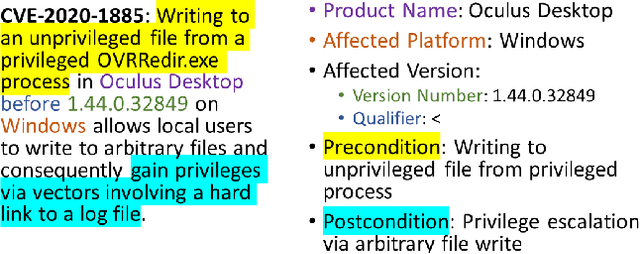
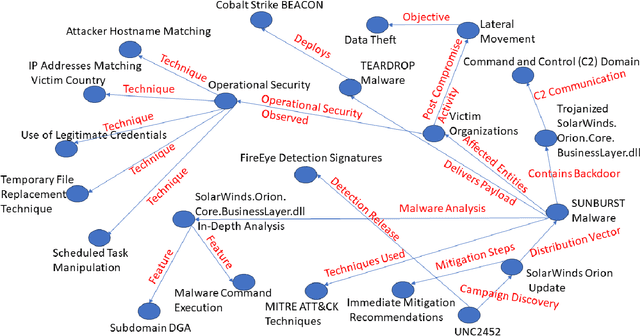


Abstract:As the complexity of modern systems increases, so does the importance of assessing their security posture through effective vulnerability management and threat modeling techniques. One powerful tool in the arsenal of cybersecurity professionals is the attack graph, a representation of all potential attack paths within a system that an adversary might exploit to achieve a certain objective. Traditional methods of generating attack graphs involve expert knowledge, manual curation, and computational algorithms that might not cover the entire threat landscape due to the ever-evolving nature of vulnerabilities and exploits. This paper explores the approach of leveraging large language models (LLMs), such as ChatGPT, to automate the generation of attack graphs by intelligently chaining Common Vulnerabilities and Exposures (CVEs) based on their preconditions and effects. It also shows how to utilize LLMs to create attack graphs from threat reports.
Universally Harmonizing Differential Privacy Mechanisms for Federated Learning: Boosting Accuracy and Convergence
Jul 24, 2024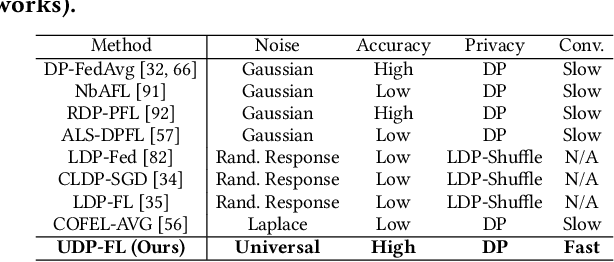

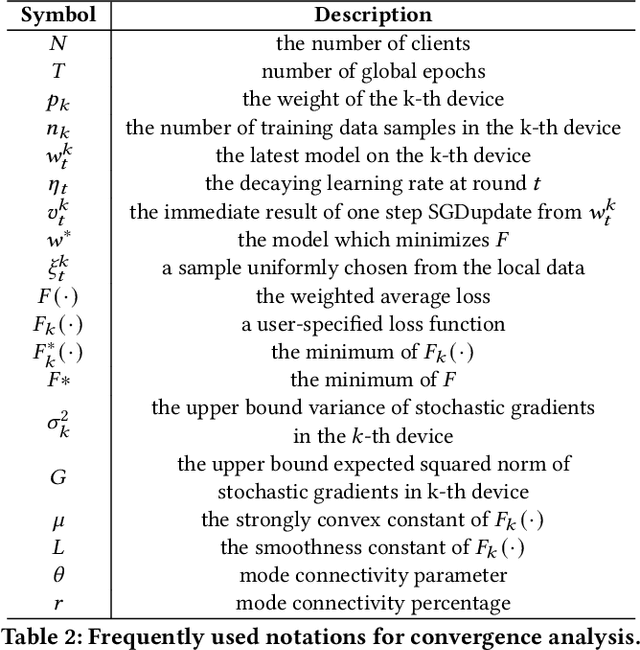
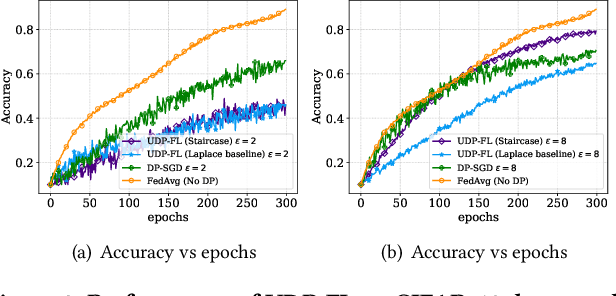
Abstract:Differentially private federated learning (DP-FL) is a promising technique for collaborative model training while ensuring provable privacy for clients. However, optimizing the tradeoff between privacy and accuracy remains a critical challenge. To our best knowledge, we propose the first DP-FL framework (namely UDP-FL), which universally harmonizes any randomization mechanism (e.g., an optimal one) with the Gaussian Moments Accountant (viz. DP-SGD) to significantly boost accuracy and convergence. Specifically, UDP-FL demonstrates enhanced model performance by mitigating the reliance on Gaussian noise. The key mediator variable in this transformation is the R\'enyi Differential Privacy notion, which is carefully used to harmonize privacy budgets. We also propose an innovative method to theoretically analyze the convergence for DP-FL (including our UDP-FL ) based on mode connectivity analysis. Moreover, we evaluate our UDP-FL through extensive experiments benchmarked against state-of-the-art (SOTA) methods, demonstrating superior performance on both privacy guarantees and model performance. Notably, UDP-FL exhibits substantial resilience against different inference attacks, indicating a significant advance in safeguarding sensitive data in federated learning environments.
 Add to Chrome
Add to Chrome Add to Firefox
Add to Firefox Add to Edge
Add to Edge